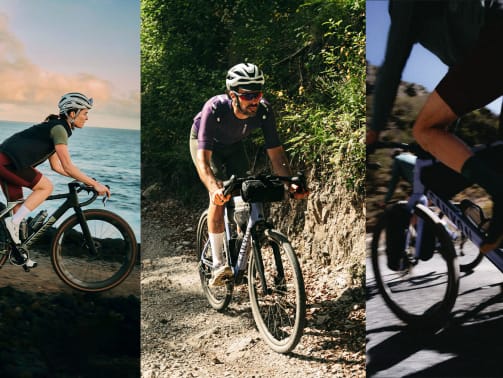Gravel bike gearing: 1x vs 2x groupsets
Should you run 1by or 2by? We help you find the best option for your gravel bike.


As is often the case, it depends, because both options have their advantages and disadvantages. Whether you enjoy riding off-road, competing in races, going on long rides, or planning your next bikepacking adventure, here's a comprehensive overview to help you make the right choice for a 1by or 2by drivetrain on your gravel bike.
1-1x vs 2x group sets on Gravel Bikes
Gravel Bikes with a one-by drivetrain - meaning with only one chainring on the crankset - are no longer a novelty. Ambitious CX riders discovered the advantages for races through rough terrain years ago. With a one-by model, shifting is simpler and the crankset wears out less quickly. Additionally, it is easier to clean, which is an important advantage after a ride in wet and muddy conditions.
However, when combined with the 7 or 8-speed cassette on the rear wheel that was common at the time, they had to accept compromises in terms of gear range. But of course, a lot has happened in this area in recent years. Today, the standard for a 1by drivetrain is 11 or 12 gears on the rear wheel. If you look in the high-end category, you will even find 1x13-speed drivetrains like the Ekar 13-speed groupset from Campagnolo.
Nevertheless, a one-by drivetrain is not always the best choice. Ultimately, it depends on your riding style and favourite routes as to whether you’ll ride better with one or two chainrings. To help you make your decision, you will learn the ideal scenarios for 1by and 2by drivetrains.
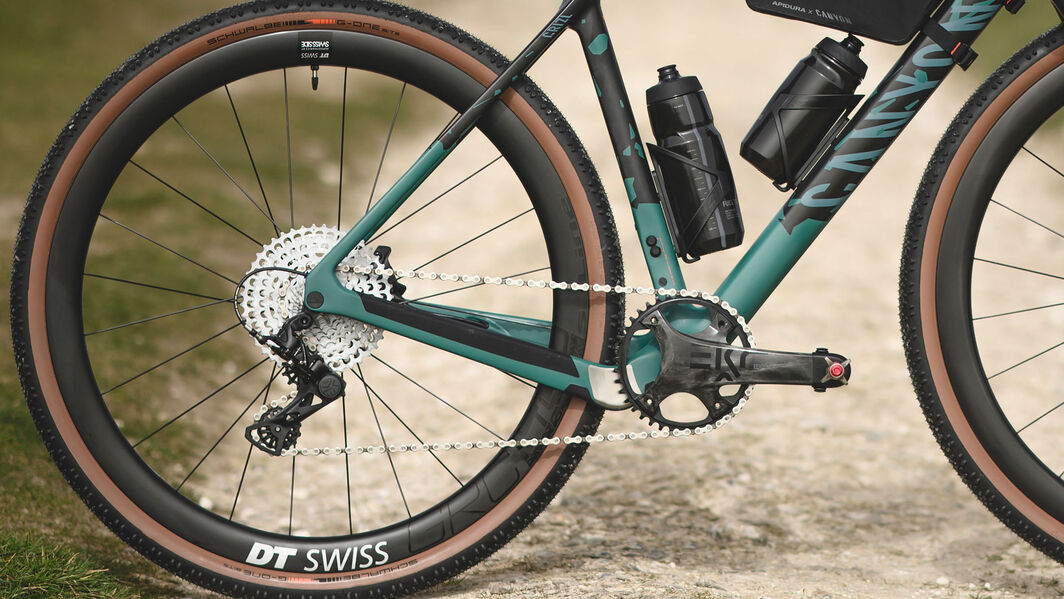
Advantages of 1by gravel bike gears
1by models offer a simple and efficient shifting logic. Having fewer gears may seem like a disadvantage at first glance. But with two or three chainrings, some gear combinations are so similar in their ratio that they are practically the same gear. In practice, a 2x11 drivetrain doesn't actually have 22 different gears, but more like 14 or 15. You don't have to worry about these duplications with a single drivetrain. With a perfectly tuned 1x11, 1x12, or 1x13 drivetrain, you can focus entirely on your ride, and the shifting happens almost effortlessly.
Admittedly, a 1x11 drivetrain has a relatively limited gear range. However, a generous 12- or 13-speed cassette already provides an impressive range. Although the gear steps are inevitably larger, technically sophisticated 1by drivetrains can easily keep up with the tried-and-tested 2by drivetrains. Some people may find single drivetrains unusual in appearance at first, but those who have tried them usually don't want to go back.
Another advantage of the 1by drivetrain is that there is no front derailleur. On bikes with multiple chainrings, the derailleur (or front mech as it is sometimes referred) is responsible for changing between them. However, during rides through challenging terrain or due to shifting errors, the front derailleur is especially susceptible to damage. This can cause the chain to jump off the chainring or get jammed, and in the worst-case scenario, lead to a crash and render the drivetrain useless. On a carbon frame, a chain jam can even result in a total disaster for the bike.
With just one chainring, these problems are a thing of the past. Firstly, all gears are easily accessible since the chainline can never become too steep. Secondly, in a 1by setup, the derailleur clutch and specially designed narrow-wide chainrings ensure that the chain runs smoothly and your chain doesn't bounce around. The term "narrow-wide" refers to the alternating narrow and wide teeth on the chainring.
An added benefit of the 1by shifting system is that the left brake lever no longer serves as a shifter. Some riders use this as an opportunity to add a dropper post to their gravel bike as the lever can be added here.
Last but not least, purists can also enjoy the visual benefits of the 1by solution. A perfectly streamlined gravel bike can be achieved with a sleek 1by shifting system, disc brakes, concealed cables, and robust wheels. The wheelbase is slightly longer than that of a road bike. With minimally profiled tyres ranging from 32 to 45 millimetres wide, you can handle almost any dry or wet terrain. This ensures a perfect balance of aesthetics and performance.
Here are the benefits of a gravel bike with a 1x drivetrain at a glance:
- Shifting is simpler to operate
- No duplication of gears
- Reduction in overall weight
- Chainline can be optimised for a single chainring
- Eliminates the need for a front derailleur, one less wear-and-tear component
- Reduced risk of shifting errors
- Dirt and mud accumulation is less likely
- Improved off-road capability
These advantages can help you save minutes during longer rides, especially when competing in gravel racing. Make sure you check out our range of racing gravel bikes before you enter your first event.
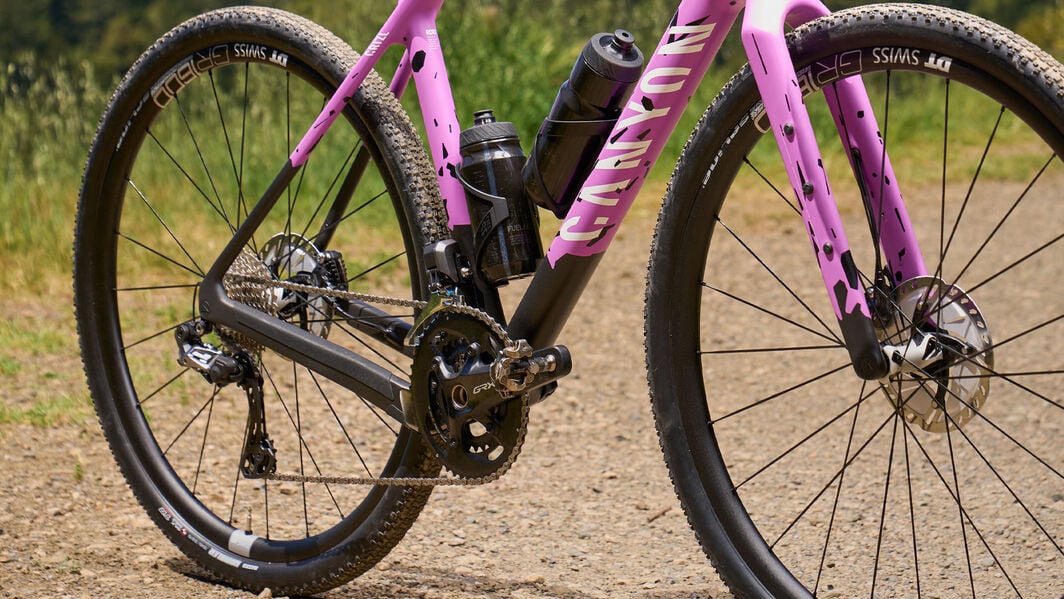
Disadvantages of the 1x drivetrain on a gravel bike
For a long time, you had to choose between a wide range of gears and fine gradation when it came to the 1by drivetrain. However, many manufacturers are now dedicating themselves to the development of their 1x drivetrains and continually bringing new, even more powerful shifting solutions to the market. Initially, single or double gear jumps were common in gear groupsets. Nowadays, you can find models with larger gradations in the lower gear range and smaller ones in the faster gears. This allows you to accelerate optimally on race sections of the course with a consistent cadence while also conquering steep climbs without constantly shifting.
Nevertheless, you still have to make compromises with a finely-graduated 1x drivetrain on a gravel bike in terms of gear range. The trend is therefore towards a 12- or 13-speed cassette, which compensates for this loss to some extent.
Here's a quick overview of the disadvantages of the 1x drivetrain on a gravel bike:
- Comparatively limited gear range with a 1x11 drivetrain
- Larger gear jumps can interfere with acceleration
- In some cases, you may have to shift through the entire cassette for large gear changes
Two or three gear jumps aren’t so bad
How well you cope with the larger gear jumps of a single-chainring drivetrain depends primarily on your riding style and intended use. In hilly terrain, you can certainly benefit from it because you can gain speed more quickly on downhill sections. When you’re climbing, bigger jumps mean easier pedalling on steep ascents.
If you ride mostly on relatively flat terrain, and perhaps occasionally on well-maintained gravel or dirt paths, you will appreciate a smaller gear jump for smoother acceleration and pedalling cadence.
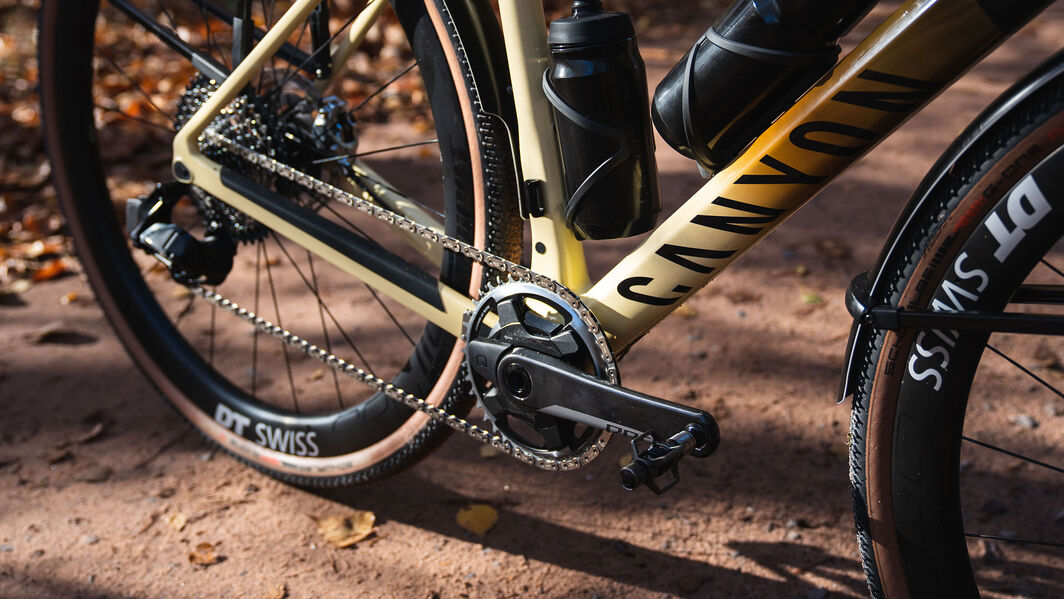
Advantages of the 2by gearing on gravel bikes
A popular alternative for recreational sports is a reliable 2by system with a good performance range and a good price-performance ratio. Such models are also fun on longer and more leisurely rides.
The advantages of the 2by shifting system on gravel bikes in summary:
- At 2x11 or 2x12, the transmission range is very generous
- 2by drivetrains have been widely used for many years and are very versatile
- Multiple chainrings allow for quick large gear changes due to the derailleur
- Many gears to choose from - especially convenient for long rides
Find out more about all-road gravel bikes designed for long rides.
Which type of rider benefits the most from a 2by groupset?
The finer gear ratios of a 2by system result in significantly less load change when shifting gears on the bicycle. This allows you to maintain a high intensity in your pedalling cadence and power through uphill climbs.
2by drivetrains are optimal for mountain bikers who want to do more than just off-road and cross-country rides. Gravel bikes with a 2by groupsets are a reliable and flexible option for both high-speed racing and extended rides. Bikepackers also appreciate the advantages of a generous selection of gears.
Find gravel bikes equipped for Bikepacking ahead of your next big trip.
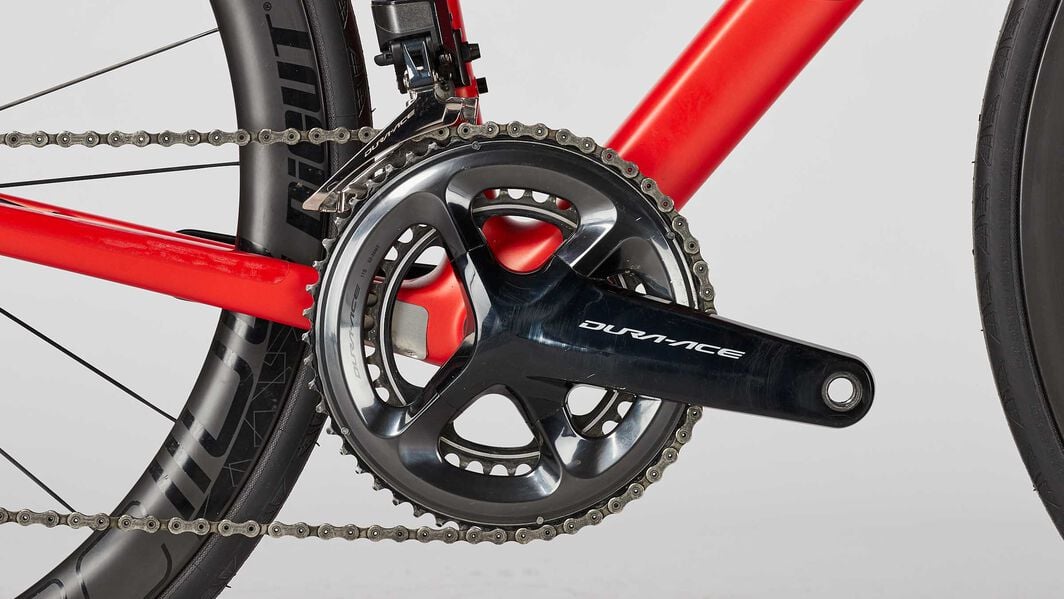
Disadvantages of 2x gearing on a gravel bike
The 2by drivetrain is a great choice for multi-surface riding. Like anything, it’s not without its disadvantages, however they’re easily mitigated.
Disadvantages of the 2-by drive at a glance:
- Higher weight due to additional components
- Chainline over the small or large chainring is not optimal
- The front derailleur is prone to errors, especially when hitting rough terrain
- Shifting errors happen even to experienced riders
- Dirt accumulates more easily on the front derailleur and chainrings
How to convert from 2by to 1by setup on your gravel bike
Still unsure whether to choose a single or double chainring for your Gravel Bike? Maybe the following info can help you make a decision: converting from a double to a single chainring is actually quite easy.
You only need to follow these four steps:
- Replace the chainring.
- Replace the cassette if you prefer a different gear ratio
- Remove the front derailleur and shift cable.
- Replace the brake lever (if using a combined brake/shift lever).
However, if your gravel bike comes equipped with a single chainring from the start, it can be quite complicated or even impossible to convert it to a double chainring. So, if you're not sure, it's safer to opt for a gravel bike with a double chainring from the get go.
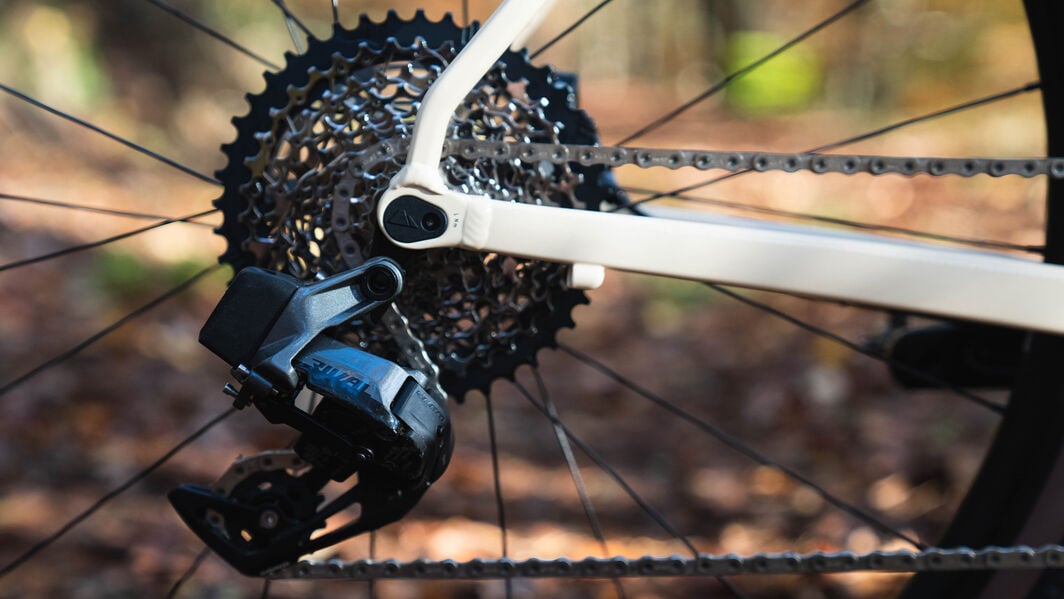
What gravel bike groupsets are available?
Wondering what gravel bike groupset options are available? We’ve gone deep into the world of gravel drivetrains in a separate article but we’ll give you a quick overview here. A few years back, you'd mainly see gravel bikes with road chainrings and a mountain bike cassette. Nowadays, however, you can easily find gravel-specific drivetrains from several major manufacturers.
Shimano's GRX was the first drivetrain specifically designed for gravel bikes. Shimano combined proven technologies from both road and mountain bike components to create solutions that are perfectly tailored to the demands of gravel riding. The complete groupset is available in various quality levels, with 1 or 2 chainrings and 10 or 11 speed cassettes. You can also choose between the mechanical and electronic versions (GRX Di2).
SRAM, the pioneer of 1by drivetrains for mountain and gravel bikes, offers gravel-specific ratios for all of its road drivetrains. The newer 1by versions of the wireless SRAM Red AXS, Force AXS, and Rival AXS drivetrains (notated by the XPLR abbreviation) boast an even wider gear range and smaller gear steps, making it easier to tackle steep climbs.
For those with a higher budget, there's the Campagnolo Ekar 1x13, a high-end solution with carbon cranks and derailleur, and buttery-smooth shifting levers that allow for multiple gear changes at once.
Still searching for your dream bike? Check out our gravel bike buyer’s guide for important information on frame geometry, choosing the right frame size, components, and more.
Canyon Gravel bikes
For races, adventures or commuting. Gravel bikes easily cover road bike distances off-road.
Discover moreDid this article help?
Thank you for your feedback
